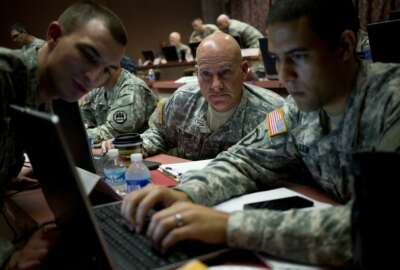The Defense Department is seeing much of its industrial base reopen after shutdowns due to the coronavirus. However, the Pentagon isn’t celebrating yet. As a second wave of COVID-19 hits the United States, DoD is reviewing policies to keep the supply chain moving and keeping an eye on the numbers.
Assistant Defense Secretary for Acquisition Kevin Fahey said only 34 of the approximately 1,000 defense-related companies that closed due to coronavirus are still shuttered. Employees are still getting infected though.
“We are seeing a lot of cases of COVID, a lot of cases in our defense industrial base, it’s pretty consistent with what you see in the news,” Fahey said Monday during a Professional Services Council webinar. “It tends to be the younger grouping of people for the most part. When more people get sick it spreads.”
He added that almost every industry partner has had confirmed COVID cases or quarantines.
Fahey said businesses and DoD have continued some operations because they’ve learned to operate under a new normal.
“We’ve figured out a lot of ways to continue to work through this activity with the extensive cleaning, taking everybody’s temperature and those kind of things,” he said. “We are nervous; we’re watching it closely. We do track where cases tend to be spiking and are working with our industry partners there.”
One of the biggest impacts of coronavirus on DoD has been the ability to test weapons systems. With government facilities closed, testing slipped and caused delays in the delivery of a product.
One of the major programs that will see delays is the Integrated Air and Missile Defense Battle Command System, a command and control weapon that shows a single view of the battlespace.
“The date we promised the solider they’d have that ability has not slipped, but we will adjust within the schedule,” Futures Command leader Gen. Mike Murray said at the end of May. “We just added the checks to this event coming up.”
Another large program expected to see changes is the Interim Maneuver Short-Range Air Defense system.
“I think we slipped it a few months to the right based on some software issues,” Murray said.
Other issues are supply chain shortages with companies not able to deliver products or parts on time. The aviation industry is DoD’s main concern with supply change because it is still being deeply affected by the impacts of coronavirus.
Also, DoD has dealt with a lack of support work from companies because of the disease.
“Support work requires traveling and in a lot of instances, distribution of parts and those kind of things. Travel restrictions had a huge impact,” Fahey said. “Most industries figured out how to clean and disinfect quickly when they do have a case of COVID. We have a big challenge across the defense industrial base making sure everybody has the right personal protection equipment.”
Coronavirus has led to some positive changes as well.
Rebecca Weirick, the executive director of the Services Acquisition Office of the deputy assistant Army secretary for procurement, said teleworking is saving money for both the Army, its employees and contractors.
She wants to entrench some of the teleworking habits.
“I’ve asked my team to write some policy ahead of necessity to allow contractors to telework into the future,” Weirick said. “We’ll see where that goes. It’s got to get through a little bit of rulemaking here in the Army to make sure that everybody’s comfortable with that. But the cost savings, the savings on commuting, the savings on employing people from all over the world really opens up a big diverse workforce opportunity for us where we’re not just employing people in the state.”
Copyright
© 2024 Federal News Network. All rights reserved. This website is not intended for users located within the European Economic Area.

